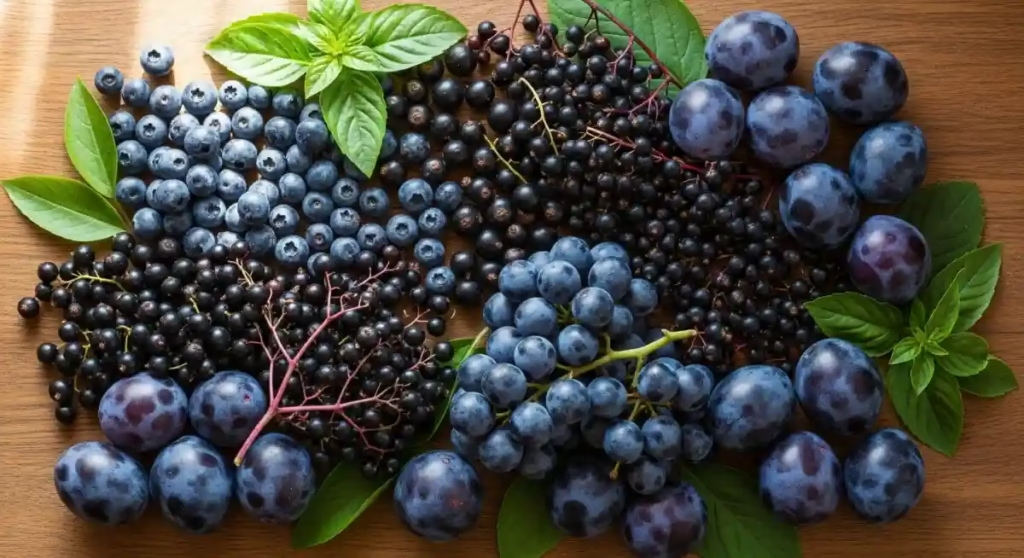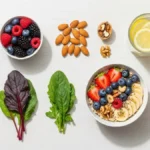Blue fruits are among the rarest and most fascinating foods in nature. From blueberries and black currants to elderberries and blue grapes, these colorful gems are not just beautiful—they are nutritional powerhouses. What makes them unique is their rich blue or purple pigment, often linked to anthocyanins, a type of antioxidant that supports heart health, brain function, and immunity.
Including more blue fruits in your diet is an easy way to improve overall wellness while enjoying delicious flavors. In this guide, we’ll explore their nutritional value, different types, health benefits, and how to add them to your meals every day.
Why Are Blue Fruits Special?
The blue, indigo, and deep purple shades of these fruits are caused by anthocyanins—a group of plant compounds that have been studied for their strong antioxidant properties. They help reduce oxidative stress, fight inflammation, and protect cells from damage.
Additionally, blue fruits are:
- Nutrient-dense: Packed with vitamins like Vitamin C, Vitamin K, and folate.
- Low in calories: Making them excellent for weight management.
- Rich in fiber: Supporting digestion and gut health.
- Good for the heart and brain: Helping reduce cholesterol and improving memory.
Top Blue Fruits You Should Know
1. Blueberries
Perhaps the most famous of all blue fruits, blueberries are widely loved for their sweet-tart taste. They are rich in Vitamin C, Vitamin K, and fiber. Research shows blueberries may help improve brain health and reduce the risk of heart disease.
How to enjoy: Add them to smoothies, oatmeal, yogurt, or simply eat them fresh.
2. Black Currants
Though dark purple, black currants fall under the blue fruit category due to their anthocyanin content. They are rich in Vitamin C—four times more than oranges!
How to enjoy: Use them in jams, teas, or sauces.
3. Elderberries
Elderberries are tiny, dark blue fruits that have long been used in traditional medicine. They are famous for boosting immunity and fighting colds and flu.
How to enjoy: Elderberry syrups, gummies, or teas are popular choices.
4. Blue Grapes
These grapes have a deep bluish hue and are loaded with resveratrol, another powerful antioxidant. They support cardiovascular health and may lower cholesterol.
How to enjoy: Eat fresh, add to salads, or enjoy as juice.
5. Haskap Berries
Also known as honeyberries, these blue fruits are native to Japan and Siberia. They contain higher antioxidant levels than many other berries.
How to enjoy: Eat fresh, add to jams, or bake into pies.
6. Blue Tomatoes (Indigo Rose)
Yes, even tomatoes can be blue! The indigo rose variety is rich in anthocyanins and antioxidants, making it as healthy as it is unique.
How to enjoy: Use them in salads, sauces, or roasted dishes.
7. Damson Plums
These small, blue-purple plums are tart yet flavorful. They are rich in fiber, vitamins, and antioxidants.
How to enjoy: Perfect for jams, chutneys, and baking.
Health Benefits of Blue Fruits
Adding blue fruits to your meals is not just about taste—it’s a step toward better health. Here are some key benefits:
1. Boosts Brain Health
Studies suggest anthocyanins in blueberries and other blue fruits improve memory, focus, and overall cognitive performance. They may even slow age-related brain decline.
2. Supports Heart Health
Blue fruits help reduce cholesterol levels, regulate blood pressure, and improve circulation. Resveratrol in blue grapes is particularly heart-friendly.
3. Strengthens Immunity
With high Vitamin C and antioxidants, fruits like elderberries and black currants are known for fighting infections and supporting a stronger immune system.
4. Improves Digestion
Their high fiber content keeps the digestive system running smoothly, preventing constipation and supporting gut bacteria.
5. Helps Manage Weight
Low in calories but high in nutrients, blue fruits make a smart choice for those aiming to maintain or lose weight.
6. Protects Against Chronic Diseases
By reducing oxidative stress and inflammation, blue fruits may lower the risk of diabetes, cancer, and neurodegenerative conditions.
How to Add Blue Fruits to Your Diet
Here are some easy ways to make these colorful fruits part of your routine:
- Breakfast: Add blueberries to oatmeal, yogurt, or smoothies.
- Snacks: Carry dried blue fruits like raisins or haskap berries.
- Lunch: Toss blue grapes into your salads.
- Dinner: Use blue tomatoes in pasta sauces or roasted dishes.
- Desserts: Enjoy elderberry jams, blueberry pies, or black currant sorbet.
Fun Facts About Blue Fruits
- Blueberries were once called “star berries” because of the star-shaped blossom on the fruit.
- Elderberries are toxic if eaten raw but safe and healthy once cooked.
- Black currants were banned in parts of the U.S. for decades because they were believed to spread tree diseases.
Why Blue Fruits Are Rare in Nature
Interestingly, blue pigments are rare in the plant kingdom. Unlike green (chlorophyll) or red (carotenoids), few natural compounds create blue hues. That’s why blue fruits are so unique and valuable in both nutrition and aesthetics.
Blue Fruits vs Other Colorful Fruits
While all colorful fruits have health benefits, blue ones stand out due to their high anthocyanin levels. For example:
- Red fruits (like strawberries) are rich in lycopene.
- Yellow/orange fruits (like mangoes) contain beta-carotene.
- Blue/purple fruits (like blueberries and grapes) excel in anthocyanins.
This makes blue fruits particularly beneficial for brain and heart health.
Potential Side Effects to Consider
Although generally safe, overconsumption of certain blue fruits (like elderberries) may cause stomach discomfort if eaten raw. Always consume them in moderation and in cooked or processed form where needed.
Final Thoughts: Embrace the Power of Blue Fruits
Incorporating blue fruits into your diet is a delicious and effective way to improve health. From boosting memory to protecting your heart, their benefits are wide-ranging. Whether you enjoy them fresh, dried, or in creative recipes, these colorful gems can transform your meals and support long-term wellness.
So next time you shop, don’t forget to add a handful of blueberries, some blue grapes, or even a jar of elderberry syrup to your basket—you’ll be nourishing your body while enjoying nature’s rarest hues.







